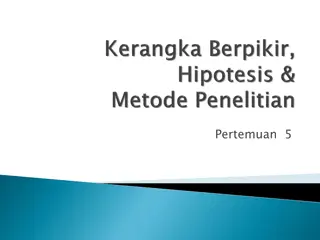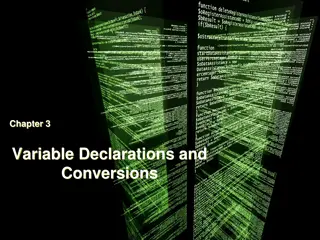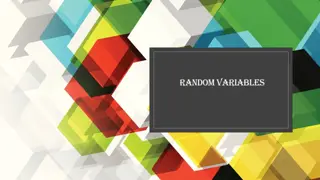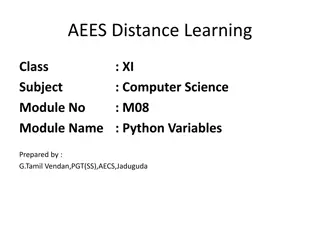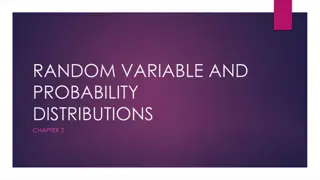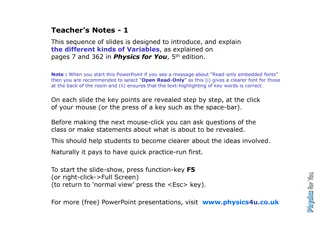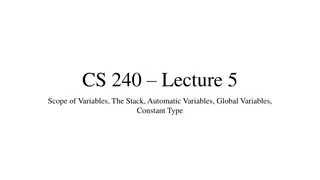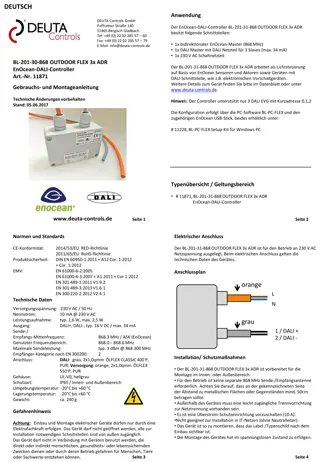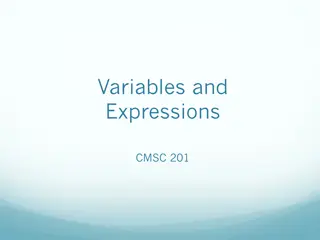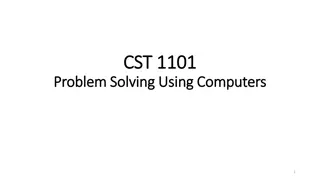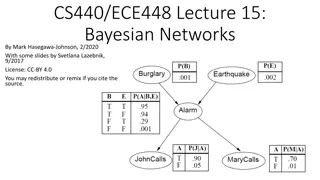
Introduction to Python Variables and Software Development Processes
Explore Python programming basics with a focus on variables and delve into the software development process steps. Learn about cowboy coding disadvantages, software design, and an example temperature converter project in this engaging lecture module.
Uploaded on | 2 Views
Download Presentation

Please find below an Image/Link to download the presentation.
The content on the website is provided AS IS for your information and personal use only. It may not be sold, licensed, or shared on other websites without obtaining consent from the author. If you encounter any issues during the download, it is possible that the publisher has removed the file from their server.
You are allowed to download the files provided on this website for personal or commercial use, subject to the condition that they are used lawfully. All files are the property of their respective owners.
The content on the website is provided AS IS for your information and personal use only. It may not be sold, licensed, or shared on other websites without obtaining consent from the author.
E N D
Presentation Transcript
CMSC201 Computer Science I for Majors Lecture 03 Variables Prof. Katherine Gibson www.umbc.edu Based on slides by Shawn Lupoli and Max Morawski at UMBC
Last Class We Covered Algorithms Program Development Control Structures Sequential Decision Making Loops Types of Errors Syntax Logic 2 www.umbc.edu
Any Questions from Last Time? www.umbc.edu
Todays Objectives To start learning Python To learn more about variables How to use them Different types To learn how to use input and output To do interesting things with our program To play a party game 4 www.umbc.edu
Cowboy Coding Jumping right in to writing code Disadvantages No formal management of project No standard way of coding Not planning things out Forgetting to include important things Having to make big changes later 5 www.umbc.edu
Software Development Process 1. Analyze the problem Determine specifications (requirements) 2. Create a design 3. Implement the design 4. Test and debug the program 5. Maintain the program 6 www.umbc.edu
Example: Temperature Converter You have been invited to live in Europe during a semester abroad. You aren t sure how to dress because the temperature is given in Celsius. Problem: Temperature is given in Celsius Solution: Write a program to convert Celsius to Fahrenheit 7 www.umbc.edu
Input/Process/Output Input What information do you need for your converter? Process What formulas do you need for your converter? Output What is the output from your converter? 8 www.umbc.edu
Introduction to Python (Variables) www.umbc.edu
Python Python is a widely used language General purpose High-level language Emphasizes code readability More streamlined than some other languages 10 www.umbc.edu
Hello World! In Python: print( Hello World! ) In the C++ programming language: #include <iostream> int main() { std::cout << "Hello, world!\n"; } 11 www.umbc.edu
Elements of a Program Identifiers Variables Modules (later in the semester) Functions (later in the semester) Expressions Code that manipulates or evaluates identifiers 12 www.umbc.edu
We Start Python Today! Two ways to use python We will write programs You can write a program as a series of instructions in a file and then execute it You can also test simple Python commands in the Python interpreter. 13 www.umbc.edu
Rules for Naming Variables Variables can contain: Uppercase letters (A-Z) Lowercase letters (a-z) Numbers (0-9) Underscores (_) Variables can t contain: Special characters ($, #, &, ^, ), (, @) 14 www.umbc.edu
More Rules for Naming Variables Variables can be any length x IsKanyeRunningForPresidentIn2020 myName Variables cannot start with a digit 2cool4school is not a valid variable cool4school is a valid variable 15 www.umbc.edu
Variables and Keywords Keywords are the reserved words in Python Variables cannot be keywords or is not a valid variable name orange is an acceptable variable name 16 www.umbc.edu
What Is a Variable? Something that holds a value Can change (multiple times) Similar to variables in math In simple terms, a variable is a box that you can put stuff in 17 www.umbc.edu
Exercise: Variables Are the following legal or illegal in Python? 1spam No Illegal! raise1 Yes legal! Spam_And_Eggs Yes legal! 18 www.umbc.edu
Using Variables in Python Create a variable by declaring it Also need to initialize it Use the assignment operator (=) assignment operator richFiddy = 50000000 poorFiddy = 0.50 brokeFiddy = 0 19 www.umbc.edu
Introduction to Python (Expressions) www.umbc.edu
Expressions Programs manipulate data Allows us to do interesting things Expressions calculate new data values Use assignment operator to set new value 21 www.umbc.edu
Expressions Example variable being set assignment operator numCandy = 10 priceCandy = 0.50 totalCandy = numCandy * priceCandy value expression 22 www.umbc.edu
Common Mistake Many new programmers mix up the left and right hand sides of the assignment operator Variable being set is on the left Expression is on the right numCandy = 10 10 = numCandy 23 www.umbc.edu
Variable Types There are many different kinds of variables! Numbers Integers Decimals Booleans (True and False) Strings (collections of characters) 24 www.umbc.edu
Variables Types: Examples aString decimal_1 = 1.12 myBool = True wholeNum = 7 = "Hello class" dogName = Mrs. Wuffington classCode = 201 25 www.umbc.edu
Variable Usage Variables are designed for storing information Any piece of information your program uses or records must be stored in a variable 26 www.umbc.edu
Introduction to Python (Input and Output) www.umbc.edu
Output Output is text printed to the screen So the user can see it and respond One command for this is print 28 www.umbc.edu
Output Example print (3+4) print (3, 4, 3+4) print() print("The answer is", 3+4) 7 3 4 7 The answer is 7 29 www.umbc.edu
Output Exercise 1 What will the following code snippet print? a = 10 b = a * 5 c = "Your result is: " print(c, b) Your result is: 50 30 www.umbc.edu
Output Exercise 2 What will the following code snippet print? a = 10 b = a a = 3 print(b) could do! Any guesses? There are two possible options for what this 10 31 www.umbc.edu
Output Exercise 2 Explanation Why does it print out 10? When you set one variable equal to another, they don t become linked! After b is set to 10, it no longer has anything else to do with a 32 www.umbc.edu
Input Input is text we get from the user userNum = input("Please enter a number: ") print(userNum) The output will look like this: Please enter a number: 10 10 33 www.umbc.edu
How Input Works userNum = input("Please enter a number: ") Takes the text the user entered and stores it In the variable named userNum You can do this as many times as you like! userNum = input( Enter another number: ") userNum2 = input( Enter a new number: ") userAge = input( Please enter your age: ") 34 www.umbc.edu
Input as a String Everything that comes through input() will come in the form of a string There is a difference between "10" and 10 "10" is a two character long string 10 is understood by Python as a number 35 www.umbc.edu
Converting from String To turn an input string into a number, you can do the following: aNum = input("Enter a number: ") aNum = int(aNum) int stands for integer (a whole number) 36 www.umbc.edu
Class Exercise: Mad Libs Mad Libs is a phrasal template word game where one player prompts others for a list of words to substitute for blanks in a story, before reading the often comical or nonsensical story aloud. The game is frequently played as a party game or as a pastime 37 www.umbc.edu
Exercise: Calculating Averages Write, on paper or on your computer, a program that asks the user for two numbers and prints out the average. Make sure to use variables, and to get the input from the user! 38 www.umbc.edu
Exercise: Assignment Weighting Pretend you re writing a program to compute someone s weight grade. You have so far: hwWeight examWeight discussionWeight = 0.1 = 0.4 = 0.5 Write a program that then asks the user for their homework grade, exam grade, and discussion grade and prints out their total grade in the class. 39 www.umbc.edu
Announcements Your Lab 1 is an online lab this week! Due by this Thursday (Sept 3rd) at 8:59:59 PM Homework 1 is out Due by next Tuesday (Sept 8th) at 8:59:59 PM Both of these assignments are on Blackboard Weekly Agendas are also on Blackboard 40 www.umbc.edu


